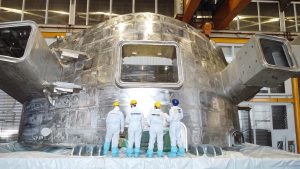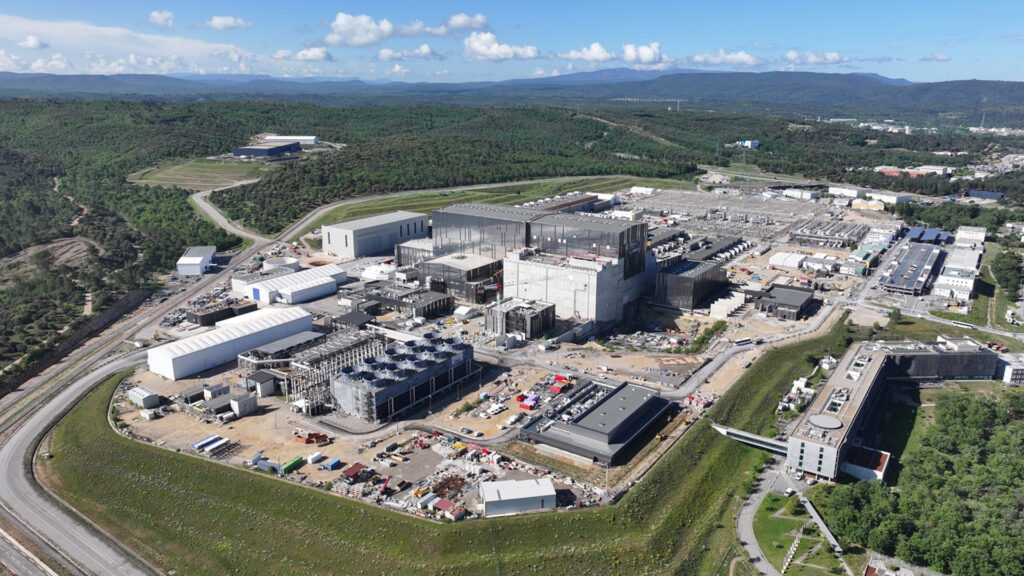The Fusion for Energy (F4E) Roundtable brings together policymakers, industry, SMEs, start-ups, and laboratories to shape tomorrow’s strategy.
Energy holds the key to our economic prosperity and social wellbeing. Europe, however, imports 60% of the energy it consumes at a cost of €1bn per day. Our continent is vulnerable to geopolitical tensions, facing attacks on its infrastructure, exposing its consumers to market volatility. We need to lower our dependence on third countries and decrease the use of fossil fuels to fight climate change, which is responsible for human and financial losses amounting to €487bn over the last 40 years in the EU.
Fusion is part of the solution
Europe is at the forefront of developing fusion – one of the most promising long-term options that could change the future. Fusion is the process that powers the Sun and other stars. It holds the key to safe, unlimited and clean power supply, offering our continent greater autonomy, security, and resilience, together with far-reaching benefits such as:
The fuels required are abundant, and even in small amounts they can generate plenty of energy. For example, 60kg of fusion fuel can provide the same amount of energy as 250,000 tonnes of oil.
No greenhouse gas emissions or long-lasting radioactive waste are produced.
Fusion power plants will offer steady and reliable energy, providing ‘baseload’ electricity.
How can fusion help Europe address its energy needs? View the video here.
Progress in Europe’s flagship fusion projects
Fusion for Energy (F4E) is the organisation of the EU managing Europe’s contribution to ITER, the largest fusion experiment ever, and other international projects. It works with companies and researchers from across the continent to deliver cutting-edge technologies and infrastructure for these projects. This investment is shaping a competitive industry, capable of manufacturing components with the highest quality standards. Working in fusion brings F4E’s supply chain an opportunity to innovate and export this knowhow to other high-tech sectors. A number of these success stories can be viewed on the technology transfer portal by F4E and EUROfusion.

In recent years, Europe’s contribution to ITER has been impressive. On site, constructors have completed many of the facilities that will host and support the massive fusion reactor, like the Tokamak Complex. As the experiment’s assembly advances, F4E and its partners have recently delivered on key components like the two first European Vacuum Vessel sectors (#5 and #4). The European teams also finished manufacturing the last and largest of the Poloidal Field coils, a record-breaking magnet of 24.7m in diameter, as well as the eight cryopumps to reach the high vacuum inside the device. Milestones like these earned F4E a strong performance rate in 2024, reaching 84% completion rate of planned activities for ITER.
In parallel, the joint experiment JT-60SA by Europe and Japan entered into operation, with its first plasma shots in late 2023. Reaching a plasma volume of up to 160m³, it was crowned as the world’s largest tokamak – a title it will hold until ITER is up and running. The teams are now upgrading it for more powerful experiments from 2026. In addition, F4E is also helping with IFMIF-DONES, an international research facility in Spain to test materials for future fusion power plants like DEMO.
Developing a European fusion strategy
Fusion energy is experiencing a momentum at the global level, thanks to technical breakthroughs, growing investment and geopolitics. Now is the time for Europe to show vision, to harness the full potential of this ‘disruptive technology’, as described in the Draghi report on EU competitiveness.
On 12-13 June, the F4E Roundtable was celebrated in Barcelona. The event brought together more than 200 representatives from EU policy, industry, SMEs, start-ups, and laboratories working in the field.
The objective was to engage with participants and listen to their views regarding Europe’s fusion ambitions. The timing couldn’t have been better, as the European Commission launched its first-ever consultation for an EU-wide fusion strategy. In the format of roundtable discussions, attendees were asked to think if we are ready to harness the potential of fusion energy; whether we have the technology, supply chain and skills; and how should Europe take the lead in this race?
Marc Lachaise, Director of Fusion for Energy, said: “The fusion energy landscape is evolving rapidly. If we are to fend off competition from other regions, we need a comprehensive plan, and we need it now.”

MEP Christophe Grudler, who recently visited ITER, contributed to the F4E Roundtable offering a strong political message: “Europe has long been a global leader in fusion, thanks to its scientific community, its skilled workforce and its investment in projects like ITER. We should remain that leader. I believe we can, but we need to act now, with a strategy to match our ambition.”
Massimo Garribba, the European Commission’s Deputy-Director General of the Directorate General for Energy, reminded participants of the upcoming discussion regarding the EU budget, stating: “If we come out with a convincing strategy that explains what needs to be done and by whom, the discussion on budget will be easier.”
Click here to view the video recording.
Europe’s way forward in an evolving landscape
The global race for fusion is accelerating, with countries like the United States and China ramping up investments and fusion start-ups emerging in the market. In this context, Europe can build on its formidable scientific legacy and pave the way to commercialisation. Its journey has been marked by pioneering experiments such as JET (1983-2023). Other devices like JT-60SA and WEST achieved the record for the world’s largest and longest plasma, respectively.
ITER is expected to provide a lot of the answers to many of the remaining technical questions in the field. F4E has invested €7bn to provide the European contribution, delivering complex components like superconducting magnets or the vacuum vessel. Manufacturing these components has given Europe’s industry the possibility to grow, and acquire new skills and expertise.
For this reason, participants insisted that ITER is not the endpoint. It’s a point of departure for this exciting technological journey. Europe needs more projects to run in parallel to cover technological gaps, such as materials or tritium breeding, and to keep the supply chain engaged. This continuity is vital to consolidate a competitive industry and shape a mature fusion market.
The panellists pointed out that the EU’s future fusion strategy should define all the needs and plan the instruments to tackle them, including public-private partnerships. Ultimately, the next EU Multiannual Financial Framework (2028-2034) will be critical to sustain Europe’s potential in the global race.

Click here to view the video recording.
What’s next for Europe’s fusion industry?
Recognising fusion as a key technology in a vibrant ecosystem was the starting point of the discussion. F4E has successfully involved in ITER more than 2,700 companies and at least 75 R&D organisations, as part of Europe’s contribution. An external study calculated that the contracts awarded by F4E in 2008-2017 resulted in more than 400 new technologies, tools and processes, while generating at least 20 start-ups and joint ventures.
This investment is delivering tangible benefits by stimulating innovation, generating technology transfers, and positioning Europe at the forefront with the support of a competitive fusion supply chain. But to keep its lead, Europe must scale up its industrial readiness; otherwise, it risks falling behind. Empowering companies as equal partners, and not treating them only as suppliers, is key to reach a more agile environment that will help them unleash their potential.
A resilient, scalable, skilled and diverse workforce holds the key to Europe’s success. F4E, with its Technology Development Programme, can play a crucial role in addressing technical gaps and building competencies, while promoting closer collaboration with private entities through specific agreements.
Another observation was that the time for public-private partnerships is now! However, to make a success out of them, there needs to be convergence amongst the different fusion associations, clearer vision, and some creative thinking in addressing intellectual property. Companies requested a long-term strategy offering business continuity, the right regulatory framework, and guarantees in terms of investment. Engaging with companies within the fusion ecosystem is important to co-share the technological and commercial risk. SMEs are also at the heart of the supply chain, making it necessary to involve them at an early stage to ensure a return of investment. When addressing the international competition Europe faces from other countries, experts agreed that it will come down to who will deliver first and not necessarily best.

Click here to view the video recording.
What skills and technologies for the future?
The delivery of fusion energy is a multi-generational endeavour requiring from those involved to attract new talent and offer meaningful career paths. Europe is well-positioned because it masters knowledge and counts several centres that could provide training. The best way to achieve this objective is to align, act, and accelerate. Starting by investing in education and training initiatives like Erasmus Mundus or mobility schemes between academia and industry. In parallel, universities and companies need to build a strong reputation for the fusion ecosystem, making room for diverse careers such as engineering, project management, procurement, legal, business, marketing, communication, etc.
Upskilling and reskilling of workforces will also be fundamental to cover the job market and the technology needs. To compensate for the low levels of readiness of some key technologies, new facilities must be created. They can in turn become technology hubs offering hands-on experience to tomorrow’s workforce. Stronger collaboration between different stakeholders, and better governance will help Europe capitalise on talent, manage resources efficiently, and deliver in line with the priorities of an EU strategy.

Click here to view the video recording.
Empowering start-ups and attracting investment
According to the recent analysis by the F4E Fusion Observatory, global investment in the private sector has surged in the last years, up to almost €10bn at present. However, Europe receives only 5% of the total, compared to the 60% for the US (home of most companies). The panellists, including start-ups and investors, considered this gap a concern and highlighted concrete actions to de-risk and empower private initiatives.
In terms of access to capital, speakers agreed that funding mechanisms like those of the European Innovation Council can be scaled up and made more flexible and responsive. Political backing and regulatory clarity are also essential to create a more attractive environment for private investment.

Besides, public support initiatives like the ITER Organization’s knowledge transfer or F4E’s call for collaboration can help novel players grow. In fact, one of the main takeaways of the event was the need for public-private partnerships to strengthen the European ecosystem. In addition, the input from companies can shape policies in more practical and impactful ways. In this context, the upcoming European fusion strategy is an opportunity to align public and private efforts in the benefit of Europe’s competitiveness in fusion.
Click here to view the video recording.
From ideas to action
The event highlighted how timing matters for Europe in order to capitalise on the expertise of F4E and its potential to act as an innovation hub, how to keep active the biggest supply chain connecting companies with laboratories and making the best use of the EU budget to face the challenges of the future. A short report with policy recommendations identifying the main takeaways and ways forward will be published this autumn.
Take a look at some of the best moments of the event here.
Please note, this article will also appear in the 23rd edition of our quarterly publication.
Source link

